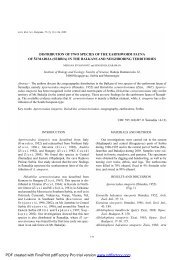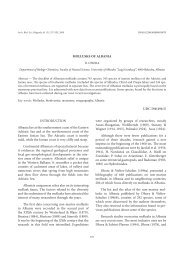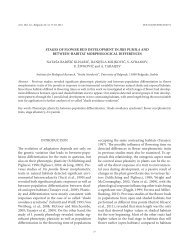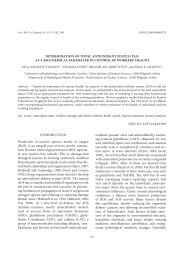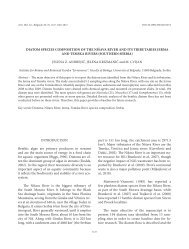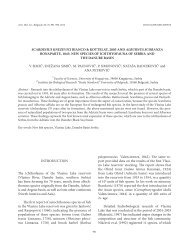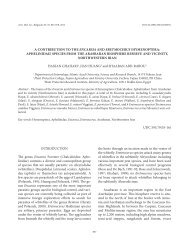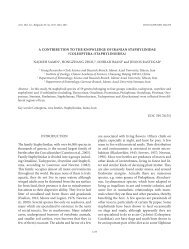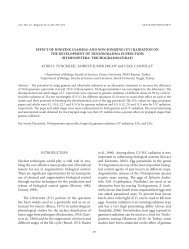BACTERIOPHAGE λ PROLIFERATION IN ESCHERICHIA COLI ...
BACTERIOPHAGE λ PROLIFERATION IN ESCHERICHIA COLI ...
BACTERIOPHAGE λ PROLIFERATION IN ESCHERICHIA COLI ...
You also want an ePaper? Increase the reach of your titles
YUMPU automatically turns print PDFs into web optimized ePapers that Google loves.
Arch. Biol. Sci., Belgrade, 62 (4), 935-940, 2010 DOI:10.2298/ABS1004935M<br />
<strong>BACTERIOPHAGE</strong> <strong>λ</strong> <strong>PROLIFERATION</strong> <strong>IN</strong> <strong>ESCHERICHIA</strong> <strong>COLI</strong> UNDER THE <strong>IN</strong>FLUENCE OF<br />
MICROWAVE IRRADIATION<br />
NATAŠA MILOJEVIĆ 1 , D. STANISAVLJEV 2 , BILJANA NIKOLIĆ 1 *, M. BELJANSKI 3 ,<br />
LJILJANA KOLAR-ANIĆ 2 and JELENA KNEŽEVIĆ-VUKČEVIĆ 1<br />
1 Chair for Microbiology, Faculty of Biology, University of Belgrade, 11000 Belgrade, Serbia<br />
2 Faculty of Physical Chemistry, University of Belgrade, 11000 Belgrade, Serbia<br />
3 Institute of General and Physical Chemistry, University of Belgrade, 11000 Belgrade, Serbia<br />
Abstract - The influence of microwaves on bacterial metabolism was investigated using the proliferation of<br />
bacteriophage <strong>λ</strong> in Escherichia coli cells as a model system. All experiments were performed under the same microwave<br />
absorption rate and constant temperature. Microwave treatment had no effect on bacterial or phage viability, or on<br />
phage adsorption. Microwaves significantly influenced phage proliferation but the effects depended on the experimental<br />
temperature. The kinetics of phage proliferation decreased with irradiation at the optimal temperature and increased at<br />
the suboptimal temperature. This result could be ascribed to the specific thermal effects of microwaves.<br />
Key words: <strong>λ</strong> bacteriophage, Escherichia coli, microwave irradiation<br />
<strong>IN</strong>TRODUCTION<br />
After several decades of research on the interaction<br />
of microwaves (MW) with biological systems, heating<br />
arising from MW absorption by the ubiquitous<br />
water solutions has been recognized as their main<br />
effect. However, numerous observations indicate<br />
that in addition to heating, MW might also induce<br />
so called non-thermal effects (Loupy, 2005, De la<br />
Hoz et al., 2005, Stanisavljev et al., 2006).<br />
It is generally recognized that MW effects<br />
include thermal effects, specific thermal effects and<br />
non-thermal effects (Loupy, 2005, De la Hoz et al.,<br />
2005, Kappe and Stadler, 2005). The thermal effects<br />
caused by MW irradiation are related to the rapid<br />
increase of temperature due to the efficient<br />
absorption of MW energy by the irradiated medium.<br />
Specific microwave effects are essentially<br />
thermal effects, but not reproducible by conventional<br />
heating due to the different distribution of<br />
heat. They are particularly emphasized in systems<br />
containing separate phases with different absorption<br />
of MWs. The source of specific effects may also<br />
935<br />
UDC 579.22:577.34.544.032.6<br />
be due to the non-homogenous nature of the MW<br />
field and the irradiated sample which can both<br />
create hot spots and higher local temperatures from<br />
expected values. If thermal and specific thermal<br />
effects cannot explain the observed MW effects,<br />
non-thermal effects are invoked ((Loupy, 2005, De<br />
la Hoz et al., 2005). Possible explanations of the<br />
non-thermal effects are given in more details by<br />
Pereux and Loupy (2001).<br />
Due to the increased use of MW appliances in<br />
everyday life, an understanding of possible MW<br />
effects on biological systems is of particular interest.<br />
The effects of MW on bacteria and viruses have<br />
been investigated by several authors. Some have<br />
concluded that the inactivation of bacteria by MW<br />
is entirely by heat, through the same mechanisms as<br />
conventional heating, such as protein and nucleic<br />
acid denaturation, as well as disruption of membranes.<br />
For example, Heddleson and Doores (1994),<br />
Woo et al. (2000) and Datta and Davidson (2001)<br />
found severe damage on the cell surface, protein<br />
and DNA leakage and the appearance of dark spots<br />
in Escherichia coli and Bacillus subtilis cells as a
936 NATAŠA MILOJEVIĆ ET AL.<br />
result of MW treatment. They also indicated that<br />
most of the MW-treated cells were "ghost cells''<br />
from which intracellular material has been released<br />
into the medium. The effects of MW irradiation on<br />
the survival of bacteriophage PL-1 was studied by<br />
Kakita et al. (1999). They reported that MW irradiation<br />
broke the DNA located in the phage core,<br />
and that most of the particles turned out to be ghost<br />
particles (with empty heads), whereas conventional<br />
heating of the phage particles did not produce such<br />
effects.<br />
In our previous work we demonstrated the<br />
inhibitory effects of MW irradiation on the kinetics<br />
of pepsin-catalyzed degradation of bovine serum<br />
albumin in vitro (Pavelkić et al., 2009). Here we<br />
describe the influence of MWs on bacterial metabolism<br />
using the proliferation of bacteriophage <strong>λ</strong> in<br />
Escherichia coli cells as a model system. All experiments<br />
were conducted under a controlled temperature<br />
of the supporting medium and constant MW<br />
energy density. Well-defined reaction conditions<br />
enabled a more precise analysis of the obtained<br />
results.<br />
MATERIAL AND METHODS<br />
Chemicals and media<br />
The Luria-Bertani medium (LB) for bacterial<br />
growth consisted of 10 g bacto-tryptone, 5 g yeast<br />
extract, and 5 g NaCl, adjusted to pH 7.5 with 1 M<br />
NaOH. The Luria agar (LA) solid medium was the<br />
same as the LB but contained 15 g agar. The<br />
Tryptone Agar semi-solid medium (TA7) contained<br />
10 g bacto-tryptone, 5 g NaCl, and 7 g agar (pH<br />
7.5). The Tryptone agar (TA15) was the same as TA7<br />
but contained 15 g agar. All media were manufactured<br />
by Difco & Co, Corpus Christi, TX, USA.<br />
Biological materials<br />
Stationery or exponential cultures of E. coli SY252<br />
(Nikolić et al., 2004) and E. coli C600 (Appleyard,<br />
1954) were used. The <strong>λ</strong> wild-type bacteriophage<br />
from lysogenic E. coli K12 (Jeffrey, 1972) was from<br />
the Faculty of Biology’s laboratory collection.<br />
Microwave irradiation<br />
MW irradiation was performed in a single mode<br />
focused CEM reactor (Model Discover, CEM Co.,<br />
Matthew, NC) working at 2.45 GHz with the ability<br />
to control output power. The temperature in the<br />
system was measured by a fiber optic temperature<br />
sensor preventing interaction with MW and<br />
influence on the temperature reading. An external<br />
cooling reaction mixture provided the constant<br />
temperature and irradiation power. The absorbed<br />
MW power Pabs = mC( dT dt)<br />
was calculated by<br />
i<br />
the calorimetric method measuring the temperature<br />
increase during the initial heating period( dT dt ) .<br />
i<br />
The initial heating period was characterized by a<br />
linear increase of temperature during which<br />
dissipation of heat by the external thermostat was<br />
small (after about 3 min the system achieved a<br />
stationary state where heat removed by the<br />
thermostat and heat evolved by the MW are<br />
equilibrated, preserving a constant temperature).<br />
The heat capacity Cp of the solution was approximated<br />
with the capacity of water. In order to keep<br />
a uniform temperature the sample was mixed with a<br />
magnetic stirrer at 400 rpm. The absorbed power of<br />
the 6 ml solution was calculated to be 5±0.5 W for<br />
the emitted power by the instrument of 100 W.<br />
With the applied experimental design, the<br />
temperature was maintained within 1oC in all<br />
experiments, along with a specific absorbed rate<br />
(SAR) of 0.82±0.09 W/g.<br />
The influence of MW irradiation on E. coli viability<br />
Fresh stationary (OD600 ~ 0.9) or exponential<br />
(OD600 ~ 0.5) cultures of E. coli SY252 strain were<br />
centrifuged at 900 x g for 10 min at 4 and the<br />
cells were resuspended in 10 mM MgSO4. The<br />
bacterial suspension (6 ml) was incubated under<br />
MW for 60 min at a constant temperature (37 )<br />
and mechanically stirred at 400 rpm. Unirradiated<br />
controls were incubated under the same<br />
experimental conditions. At 10 min intervals the<br />
aliquots of 10 μl were taken from the irradiated<br />
and control suspensions for colony forming unit<br />
(CFU) measurement.
The influence of MW irradiation<br />
on bacteriophage <strong>λ</strong> viability<br />
The phage stock dilution (6 ml) was incubated under<br />
MW for 60 min at a constant temperature<br />
(37 ) and mechanically stirred at 400 rpm. An<br />
unirradiated control was incubated under the same<br />
experimental conditions. At 10 min intervals the<br />
aliquots of 10 μl were taken from the irradiated and<br />
control suspensions for plaque forming unit (PFU)<br />
measurement.<br />
The influence of MW irradiation on bacteriophage <strong>λ</strong><br />
adsorption on E. coli<br />
The exponential culture of SY252 (6 ml) was<br />
mixed with 0.1 ml of an appropriate phage stock<br />
dilution and incubated under MW for 20 min at<br />
37 in order to enable viral adsorption. The<br />
dilution of phage was prepared to adjust the<br />
multiplicity of infection (MOI) to 0.01 (1<br />
infective virion per 100 cells). The unirradiated<br />
control mixture was incubated under the same<br />
experimental conditions. After adsorption, the<br />
cells from the irradiated and control mixtures<br />
were separated from the unadsorbed virions by<br />
centrifugation (1400 x g for 15 min at 4 ) and<br />
plated for PFU measurement.<br />
The influence of MW irradiation on bacteriophage <strong>λ</strong><br />
proliferation in E. coli<br />
The exponential culture of SY252 (6 ml) was<br />
mixed with 0.1 ml of an appropriate phage stock<br />
dilution and incubated for 20 min at 37 in<br />
order to enable viral adsorption. The dilution of<br />
phage was prepared to adjust the multiplicity of<br />
infection (MOI) to 0.01. After adsorption the<br />
cells were separated from the unadsorbed virions<br />
by centrifugation (1400 x g for 15 min at 4 ) and<br />
resuspended in an LB medium (6 ml) containing<br />
1 % glucose and incubated for 100 min at a<br />
constant temperature (37 or 33 ) with or<br />
without MW. Both mixtures were mechanically<br />
stirred at 400 rpm. At 25 min intervals the<br />
aliquots of 10 μl were taken from MW irradiated<br />
and control mixtures for PFU measurement.<br />
<strong>BACTERIOPHAGE</strong> <strong>λ</strong> <strong>PROLIFERATION</strong> <strong>IN</strong> <strong>ESCHERICHIA</strong> <strong>COLI</strong> 937<br />
Statistical analyses<br />
The Student t-test (Samuels and Witmer, 2003) was<br />
employed for statistical analysis. All calculated<br />
errors represent 95% confidence limits of the mean.<br />
RESULTS AND DISCUSSION<br />
The influence of MW irradiation on bacteriophage<br />
<strong>λ</strong> proliferation has been analyzed under non-lethal<br />
conditions for either host cells or phage. Firstly, we<br />
examined the effect of MW irradiation on bacterial<br />
and viral viability. The effect of MW on the process<br />
of phage adsorption was also investigated and ultimately<br />
the effect of MW on phage proliferation inside<br />
the host cell. The influence of MW irradiation<br />
was monitored in experiments performed under the<br />
controlled bulk temperature of the supporting medium<br />
and constant MW energy density.<br />
The influence of MW irradiation on E. coli and<br />
phage viability<br />
MW irradiation was performed at a temperature of<br />
37°C, which is optimal for the growth of E. coli. The<br />
influence of MW was monitored in the exponential<br />
phase of the growth cycle in which cell metabolism was<br />
most intense, and during the stationary phase when<br />
metabolic processes were slower. The effect was analyzed<br />
by determining the number of CFU as a function<br />
of MW treatment duration. The results showed that 60<br />
min of MW irradiation did not induce any lethal effect<br />
in the SY252 strain in either the stationary (Tab. 1A) or<br />
exponential (Tab. 1B) phases of growth.<br />
The effect of MW on the viability of the metabolically<br />
inactive viral suspension was also examined at a<br />
temperature of 37°C. The results presented in Tab. 2<br />
show that MW did not reduce phage infectivity.<br />
The influence of MW irradiation on bacteriophage <strong>λ</strong><br />
adsorption on E. coli<br />
Since we have demonstrated that MW irradiation<br />
had no effect on the viability of either the host cells<br />
or phage, we examined the influence of MW irradiation<br />
on the process of phage adsorption. The ab-
938 NATAŠA MILOJEVIĆ ET AL.<br />
Table 1A.<br />
time, min<br />
Table 1B.<br />
CFU number/ml<br />
MW irradiated controle<br />
0 (2.28 ± 0.18) · 10 9 (2.82 ± 0.19) · 10 9<br />
10 (2.29 ± 0.07) · 10 9 (1.99 ± 0.30) · 10 9<br />
20 (2.46 ± 0.14) · 10 9 (2.88 ± 0.36) · 10 9<br />
30 (2.36 ± 0.72) · 10 9 (2.60 ± 0.18) · 10 9<br />
40 (2.64 ± 0.47) · 10 9 (2.88 ± 0.33) · 10 9<br />
50 (2.24 ± 0.13) · 10 9 (2.56 ± 0.25) · 10 9<br />
60 (2.48 ± 0.06) · 10 9 (2.19 ± 0.17) · 10 9<br />
time (min)<br />
MW irradiated<br />
CFU number/ml<br />
0 (3.82 ± 0.14) · 10 6 0<br />
10 (3.86 ± 0.22) · 10 6 10<br />
20 (3.37 ± 0.11) · 10 6 20<br />
30 (3.55 ± 0.07) · 10 6 30<br />
40 (4.41 ± 0.01) · 10 6 40<br />
50 (3.90 ± 0.09) · 10 6 50<br />
60 (2.59 ± 0.06) · 10 6 60<br />
sorption of viruses on bacteria was investigated<br />
during the incubation period of 20 min in the MW<br />
field and in control cultures without MW. The<br />
results presented in Table 3 show that there was no<br />
significant difference between the number of adsorbed<br />
phages with MW treatment and without it,<br />
indicating that MW irradiation had no effect on<br />
phage adsorption on the host cell.<br />
The influence of MW irradiation on bacteriophage <strong>λ</strong><br />
proliferation in E. coli<br />
We examined the effect of MW on phage proliferation<br />
at 37°C, the temperature optimal for host<br />
Table 2.<br />
time (min)<br />
Table 3.<br />
MW irradiated<br />
PFU number/ml<br />
0 (9.10 ± 1.51) · 10 7 0<br />
10 (9.63 ± 2.08) · 10 7 10<br />
20 (7,33 ± 2,18) · 10 7 20<br />
30 (8.23 ± 1.89) · 10 7 30<br />
40 (1.06 ± 0.31) · 10 8 40<br />
50 (9.67 ± 1.10) · 10 7 50<br />
60 (7.33 ± 2.84) · 10 7 60<br />
Sample PFU number/ml<br />
MW irradiated (1.24 ± 0.28) · 10 5<br />
control (1.43 ± 0.11) · 10 5<br />
cells. After initial phage adsorption, the infected<br />
cells were incubated during viral proliferation in an<br />
MW field or outside it. As expected, after a short<br />
latent period the number of PFU increased due to<br />
the release of the new phage particles from the infected<br />
cells (Hershey, 1971) both with and without<br />
MW treatment. The comparison between the MW<br />
irradiated and control cultures revealed significant<br />
differences in the PFU number in time. Fig. 1A<br />
shows that the kinetic curve of phage release was<br />
decreased with irradiation. This result indicated<br />
that MW could affect cell metabolism and consequently<br />
phage proliferation, but gave no answer to<br />
the mechanism involved. In order to elucidate if the<br />
thermal or non-thermal effects of MW were responsible,<br />
we performed the same experiments, but<br />
at a suboptimal temperature (33°C). the obtained<br />
results (Fig. 1B) indicated that MW also influenced<br />
phage proliferation, but in a different manner; i.e.,<br />
the kinetic curve of phage release was increased<br />
with irradiation at a suboptimal temperature.
Fig. 1A.<br />
*factor of phage proliferation was calculated by dividing the number of<br />
PFU/ml in each time with the number of PFU/ml in 0 min.<br />
The comparison of results obtained at different<br />
temperatures indicated opposite effects of MW on<br />
phage proliferation at optimal and suboptimal temperature.<br />
While MW slowed down phage proliferation<br />
at optimal temperature, it accelerated this process<br />
at a suboptimal temperature. This indicated<br />
possible specific thermal effects of MW. Although<br />
the temperature was constant, the local overheating<br />
of E. coli cells could occur due to the different dielectric<br />
properties of the cell protoplasm and surrounding<br />
medium. This temperature increase could<br />
influence cell metabolism and phage proliferation.<br />
When the medium is kept at 37°C, this increase<br />
may lead to a local temperature of 42-43°C inside<br />
the cells, thus slowing down the phage life cycle and<br />
its proliferation. The estimated temperature increase<br />
could not be higher than 5-6 o C, since the<br />
temperature of 44-45 o C is lethal for E. coli and<br />
would cause a complete inhibition of phage proliferation.<br />
Taking into account the same arguments,<br />
when the medium is kept at 33°C a similar temperature<br />
increase would give rise to almost optimal<br />
thermal conditions for the host cells and consequently<br />
more intensive metabolism and faster phage<br />
proliferation, as observed.<br />
<strong>BACTERIOPHAGE</strong> <strong>λ</strong> <strong>PROLIFERATION</strong> <strong>IN</strong> <strong>ESCHERICHIA</strong> <strong>COLI</strong> 939<br />
Fig. 1B.<br />
*factor of phage proliferation was calculated by dividing the number of<br />
PFU/ml in each time with the number of PFU/ml in 0 min.<br />
In conclusion, the obtained results indicate that<br />
MW treatment under non-lethal conditions for<br />
either host cells or phage could affect phage proliferation<br />
inside the host cells. This influence could<br />
be ascribed to the specific thermal effects of MW,<br />
but non-thermal effects are not excluded and further<br />
experiments are necessary in order to clarify<br />
the involved mechanisms. The effects are observed<br />
at a relatively high absorbed energy of 0.82 W/g,<br />
which exceeds significantly current environmental<br />
microwave pollution and is not relevant for human<br />
health risk assessments. However, the ability to influence<br />
cell processes with MW radiation can be of<br />
significance for future biochemical studies.<br />
Acknowledgments - This study was supported by Ministry of<br />
Science of Republic of Serbia, Projects No. 142025 and<br />
143060.<br />
REFERENCES:<br />
Appleyard, R. K. (1954). Segregation of new lysogenic types<br />
during growth of a doubly lysogenic strain derived from<br />
Escherichia coli K12.Genetics 39, 440.<br />
Datta, A. K., and P. M. Davidson (2001). Microwave and radio<br />
frequency processing. J. Food Sci. 65 (Suppl.), 32.
940 NATAŠA MILOJEVIĆ ET AL.<br />
De la Hoz, A., Diaz-Ortiz, A., and A. Moreno (2005). Microwaves<br />
in organic synthesis. Thermal and non-thermal<br />
microwave effects. Chem. Soc. Rev. 34, 164.<br />
Heddleson, R. A., and S. Doores (1994). Factors affecting<br />
microwave heating of foods and microwave induced<br />
destruction of foodborne pathogens – a review. J. Food<br />
Protect. 57, 1025.<br />
Hershey, A. D. (1971). The Bacteriophage lambda. Genetic<br />
Research Unit, Carnegie Institution, Cold Spring<br />
Harbor, New York, pp. 29.<br />
Jeffrey, H.M. (1972). Experiments in molecular genetics, Cold<br />
Spring Harbor Laboratory Press, Cold Spring Harbor,<br />
New York, pp. 214.<br />
Kakita, Y., Funatsu, M., Miake, F., and K. Watanabe (1999).<br />
Effects of microwave irradiation on bacteria attached to<br />
the hospital white coats. Int. J. Occup. Med. Env. 12, 123.<br />
Kappe, O., and A. Stadler (2005). Microwaves in Organic and<br />
Medicinal Chemistry. Wiley-VCH, Weinheim, pp. 24.<br />
Loupy, A. (2005). Microwaves in Organic Synthesis. 2nd ed.,<br />
Wiley-VCH, Weinheim, pp. 61.<br />
Nikolić, B., Stanojević, J., Mitić, D.,Vuković-Gačić, B., Knežević-<br />
Vukčević, J., and D. Simić (2004). Comparative study of<br />
the antimutagenic potential of Vitamin E in different<br />
E.coli strains. Mutat. Res. 564, 31.<br />
Pavelkić, V. M., Stanisavljev, D. R., Gopcević, K. R., and M. V.<br />
Beljanski (2009). Influence of microwave irradiation on<br />
enzyme kinetics. Zh. Fiz. Khim. 83, 1.<br />
Pereux, L., and A. Loupy (2001). A tentative rationalization of<br />
microwave effects in organic synthesis according to the<br />
reaction medium and mechanistic considerations.<br />
Tetrahedron. 75, 9199.<br />
Samuels, M. L., and J. A. Witmer (2003). Statistics for the life<br />
sciences. 3rd ed. Pearson, New Jersey.<br />
Stanisavljev, R. D., Djordjević, A., and D. V. Likar-Smiljanić<br />
(2006). Microwaves and coherence in the Bray-<br />
Liebhafsky oscillatory reaction. Chem. Phys. Lett.<br />
423, 59.<br />
Woo, I. S., Rhee, I. K., and H. D. Park (2000). Differential damage<br />
in bacterial cells by microwave radiation on the<br />
basis of cell wall structure. Appl. Environ. Microb. 66,<br />
2243.<br />
ПРОЛИФЕРАЦИЈА БАКТЕРИОФАГА <strong>λ</strong> КОД <strong>ESCHERICHIA</strong> <strong>COLI</strong> ПОД УТИЦАЈЕМ<br />
МИКРОТАЛАСНОГ ЗРАЧЕЊА<br />
НАТАША МИЛОЈЕВИЋ 1 , Д. СТАНИСАВЉЕВ 2 , БИЉАНА НИКОЛИЋ 1 *, М. БЕЉАНСКИ 3 ,<br />
ЉИЉАНА КОЛАР-АНИЋ 2 И ЈЕЛЕНА КНЕЖЕВИЋ-ВУКЧЕВИЋ 1<br />
1 Катедра за микробиологију, Биолошки факултет, Универзитет у Београду, 11000 Београд, Србија,<br />
2 Факултет за физичку хемију, Универзитет у Београду, 11000 Београд, Србија,<br />
3 Институт за општу и физичку хемију, Универзитет у Београду, 11000 Београд, Србија<br />
Испитиван је утицај микроталасног зрачења<br />
на бактеријски метаболизам, на моделу пролиферације<br />
бактериофага <strong>λ</strong> у Escherichia coli. У свим<br />
експериментима апсорбовано микроталасно зрачење<br />
је било једнако, а температура је одржавана<br />
константном. Микроталаси нису имали ефекта на<br />
преживљавање ни бактерија ни фага, као ни на<br />
адсорпцију фага. Насупрот поменутом, микроталаси<br />
су утицали на пролиферацију фага, али је<br />
ефекат зависио од експерименталне температуре.<br />
Брзина пролиферације фага је била смањена на<br />
оптималној, а повећана на субоптималној температури.<br />
Добијени резултати се могу приписати<br />
специфичним термалним ефектима микроталаса.



